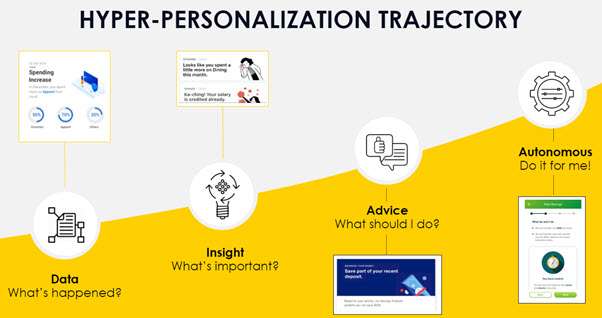What is the hyper-personalisation trajectory? A simple question with a myriad of answers. Ron Shevlin proposes “It is a series of interactions that strengthens a customer’s emotional connection to a product or company,” in his recent Forbes article. And while true, the definition still leaves a lot for interpretation. What types of interactions signify engagement? How do you measure emotional connection? The answer is the relevancy of the products to that individual consumer at a precise moment in time
A visual trajectory is best explained within the customer journey, how hyper-personalisation establishes trust, which in turn encourages enduring engagement which in turn means an increased bottom line. This is the opposite of academic papers claiming that privacy, hyper-personalisation, and autonomy harm. Higher returns are enjoyed because the greater the relevancy the greater the AOV, the greater the CLV, and the greater the ROI of the investment in hyper-personalisation offers. Underlining as always, that you can’t appreciate the reality unless you experience it first-hand.

How does the hyper-personalisation trajectory work
- Data – Forward-leaning retailers are capitalising on the ability to offer the exact most relevant product at exactly the right time — to better “know” their customer’s behaviour and deliver hyper-personalised product selections, boost sales, trust and every available metric. Long gone are the days when merely being in a segment of a cluster earns any respect, or more importantly any return for your investment, especially when you factor in staff overheads to achieve what little returns it offers in comparison.
Data-driven individualisation appears to be at a tipping point, accelerated by the actions of leading retailers and the growing body of evidence that these solutions are being embraced by consumers and delivering strong returns. It demonstrates to consumers that their preferred retailer really “knows” them and is looking out for their well-being. Consequently, it increases the value of interactions between provider and their customers, enhancing trust and deepening relationships. - Insight – data-driven hyper-personalisation engine analyses customer transaction data in real-time, applies machine learning and deep-learning AI algorithms to understand an individual’s behaviour; past, present and future, to determine what’s important, and delivers insights and advice to each customer alone.
Insights provide customers with a view of their likes, dislikes, preferences, desires and aspirations, from purchasing habits to nuanced influences and focus on the anomalies that might have otherwise been missed. Not every insight bears the same importance, and by only pointing out the relevant and valuable insights, customers become more trusting of the messenger. If your online retailer seems to always know exactly what you want, compared to one that doesn’t, who would you shop with more often? - Advice – With real-time data and relevant insights at hand, retailers will gain their customer’s trust, build loyalty and increase customer satisfaction by focusing on their customers’ needs. This shift means providing customers with hyper-personalised, relevant experiences each time they look at an email or visit your site. Building loyalty and trust will benefit more than just customers. Executed well, contextual insights represent revenue growth and productivity opportunities.
A hyper-personalisation trajectory is autonomous
It is important to emphasise the place of autonomy in this new science. the data is so powerful. Research companies including Deloitte, McKinsey and Forbes all illustrate a 20x increase in the ROI delivered. Therefore it is otherwise impossible to practically apply, the use of that data without it being autonomous. If you let humans interfere then, in addition to the enormous additional cost for doing so, you immediately incur all those foibles that come with them, namely errors and omissions. Your databank, on the other hand, works perpetually, using live data immediately to maximise relevancy for the consumer, and maximise opportunity for the retailer.
Our article on LLMs might be appropriate for a deeper technical understanding.
Consider the disparity in returns between those enjoyed by a fearless defender of style and look fashion retailer, (including in their marketing) who won’t release control of her product display content. For example within an email stylesheet, because she insists it is always done by her or one of her highly trained team. Against this is her adopting a stylesheet – capable of being tailored initially and then simply populated at will by the appropriate selection from the collected data, hyper-personalised for each consumer, nano-seconds before being sent.
Would you advocate maintaining the existing principals, or grasp the opportunity for massively greater customer affinity and 20 times higher returns by offering the precise product selection at the exact moment each individual most wants it? i.e. £10,000 GP per month again £200,000 GP per month. There is no comparison in reward, and yet, for many, this is a moral argument still being fought daily, as appreciation of the illustration is not experienced (nor expected) until tried. “How can a computer know what my customers want more than I do?” Err because it never sleeps or makes mistakes?
It should be appreciated that a well-informed and engineered stylesheet, capable of being populated in such a fashion as described above, can and has been developed. SwiftERM, for example, collected over 10 years of email marketing trial data, for some of the largest retail companies in the UK. They did so cross-client, cross-branded, using designs from a myriad collection of marketing and advertising talent, at a cost of millions. The results offer the highest performing choice, were realised and are now adopted. Further, the product copy and imagery – populating the stylesheet, is unique and personal to the retailer input it to the site. Therefore a high degree of input can and is included.
Conclusion
When a retailer takes the time and steps required to know their customers and adopt hyper-personalised product selection software, they will be rewarded with a stronger customer franchise including higher satisfaction, deeper relationships, and greater profitability.





